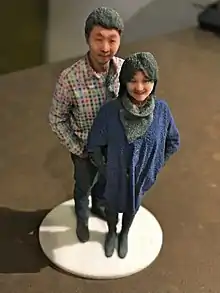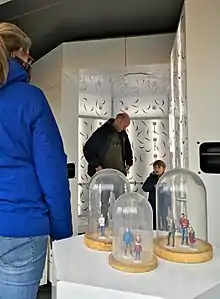3D selfie
A 3D selfie is a 3D-printed scale replica of a person or their face. These three-dimensional selfies are also known as 3D portraits, 3D figurines, 3D-printed figurines, mini-me figurines and miniature statues. In 2014 a first 3D printed bust of a President, Barack Obama, was made.[1] 3D-digital-imaging specialists used handheld 3D scanners to create an accurate representation of the President.


Description
The capture of a subject as a 3D model can be accomplished in many ways. One of the methods, is called photogrammetry. Many systems use one or more digital cameras to take 2D pictures of the subject, under normal lighting, under projected light patterns, or a combination of these. Inexpensive systems use a single camera which is moved around the subject in 360° at various heights, over minutes, while the subject stays immobile.[2] More elaborate systems have a vertical bar of cameras rotate around the subject, usually achieving a full scan in 10 seconds.[3] Most expensive systems have an enclosed 3D photo booth with 50 to 100 cameras statically embedded in walls and the ceiling, firing all at once, eliminating differences in image capture caused by movements of the subject.[4] [5][6] A piece of software then reconstructs a 3D model of the subject from these pictures.[4] [2] One of the 3D photo booth, which creates life-like portraits, is called Veronica Chorographic Scanner.[7] The scanner participated in the project of Royal Academy of Arts, where people could have themselves scanned. The scanner utilized 8 cameras taking 96 photographs of a person from each angle. Photogrammetry scanning is generally considered more life-like, than scanning with 3D scanners.[8]
Another method for capturing a 3D selfie uses dedicated 3D scanning equipment which may more accurately capture geometry and texture, but take longer to perform. Scanners may be handheld, tripod mounted or fitted to another system that will allow the full geometry of a person to be captured. One of the well-known full body 3D scanners are Shapify booth, based on Artec Eva 3D scanners and Twindom Twinstant Mobile.[9]
Production of 3D selfies[10] is enabled by 3D printing technologies. This includes the ability to 3D print in full color using gypsum-based binder jetting techniques, giving the figurine a sandstone-like texture and look.[5] Other 3D printing process may be used depending on the desired result.
 A 3D selfie seen from various angles
A 3D selfie seen from various angles Fantasitron 3D photo booth at Madurodam
Fantasitron 3D photo booth at Madurodam
References
- Milkert, Heidi (2014-06-18). "Barack Obama Has Become the First President to be 3D Scanned and Printed". 3DPrint.com.
- "The Selfie Of The Future Is A 3D Figure". Popular Science. 2015-09-12. Retrieved 2017-12-22.
- "Asda Launches £60 3D-Printed Selfie Service for UK Shoppers". International Business Times. 2014-06-25. Retrieved 2017-12-23.
- "Take Your Selfie Game to the Next Level With a 3-D Printed Statue of Yourself". Wired. 2015-02-16. Retrieved 2017-12-22.
- "This Is What It's Like To Have A 3D Selfie Taken". HuffPost. 2016-06-29. Retrieved 2017-12-23.
- "Photo booth for events". Friday, 12 April 2019
- Karin Giannone (27 September 2016). "Experiencing the Veronica Scanner at the Royal Academy of Arts". YouTube. Retrieved 2 October 2019.
- Scott, Clare (2016-07-28). "The High-Resolution Veronica Scanner Produces 3D Portraits More Realistic Than Photographs". 3DPrint.com.
- Arrighi, Pierre-Antoine (2018-07-05). "3D printed figurines: 3D portraits, 3D figurines and 3D selfies". Aniwaa.
- https://www.3dgeneration.com/3d-figuren/
| Wikimedia Commons has media related to 3D selfie. |
